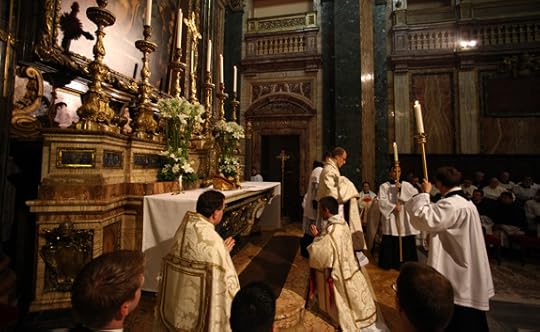The Future of Liturgical Formation and Renewal

The Future of Liturgical Formation and Renewal | CWR Staff | Catholic World Report
An interview with Dom Alcuin Reid about Sacra Liturgia 2013
At the end of June more
than 300 people gathered in Rome from over 35 countries to participate in Sacra
Liturgia 2013, an international conference on liturgical formation, celebration
and the mission of the Church, convened by the bishop of Fréjus-Toulon, France,
Bishop Dominique Rey. CWR asked Sacra Liturgia 2013’s principal organizer, Dom
Alcuin Reid, about the conference and its impact.
CWR: This was a large international conference. Were
the organizers happy with how it unfolded?
Dom Reid: More than happy, yes. Practically speaking,
hiring the facilities of the Pontifical University of Santa Croce provided an
excellent venue in the heart of Rome and the warm welcome accorded us by the rector
of the adjacent Basilica of St. Apollinare gave us a beautiful environment in
which to celebrate the sacred liturgy together. Of course, organization can
always be improved, but I think we were able to provide delegates with a
conference well worth attending and which made a significant contribution to
the Year of Faith.
In terms of content
we were blessed with first-class speakers from beginning to end. We
deliberately varied the topics around different aspects of liturgical formation
and celebration and their relationship to the life and mission of the Church in
the 21st century so as to provide a wide-ranging “diet,” as it were. This was
not a conference for “sacristy specialists” or even necessarily for liturgical
experts. Rather it was for those wishing better to understand the unique and
fundamental role of the sacred liturgy in the life of the Church—an
understanding which his necessary for all of us if we are to form and evangelize
others.
CWR: Can you say something about the different
participants?
Dom Reid: Delegates came from more than 35 countries and
from very different backgrounds. Lay men and women involved in different
aspects of ministry in their parishes and dioceses, many priests of course,
religious men and women, as well as students and seminarians. Many of these
delegates were young—including one group of college students from the United
States who saved up to come—showing that the “question of the liturgy” is very
much alive for their generation. Some bishops and an abbot came as delegates in
order to further their own liturgical formation. So too there were a number of
professors of liturgy and liturgical formators from seminaries and universities
present. We also were honored by the participation of the ambassadors to the
Holy See of Great Britain, Australia, and South Korea.
Speakers too, came
from around the globe. Cardinal Ranjith came especially from Sri Lanka, and we
were fortunate that Archbishop Sample, Bishop Elliott, and Professor Rowland
were all in Rome for other engagements during that week and could join us.
Roman residents Cardinals Canizares, Burke, and Brandmueller, Msgr. Heid and Father
Gunter joined us. Bishop Aillet and Abbot Nault came from France, Msgr. Newton
and Father Lang from England, and others from Italy, Germany, Spain, and the
United States.
One thing that struck
me about the participants was the overall tone, particularly in the
discussions. There was no negativity or focus on past problems. Rather, it was
evident that all were looking forward with great hope and confidence to future
renewal in liturgical formation and celebration. In a way this encapsulates the
spirit of Sacra Liturgia 2013: no one present denied that there have been
serious liturgical problems in recent decades, but all were united in the
conviction that we must play our part in solving them. There was a tangible
spirit, a momentum, in the participants that will bear much fruit in the
future.
CWR: You spoke of problems that need to be solved.
In the ongoing reform of the liturgy, what still needs to be done, and how?
Carl E. Olson's Blog
- Carl E. Olson's profile
- 20 followers



